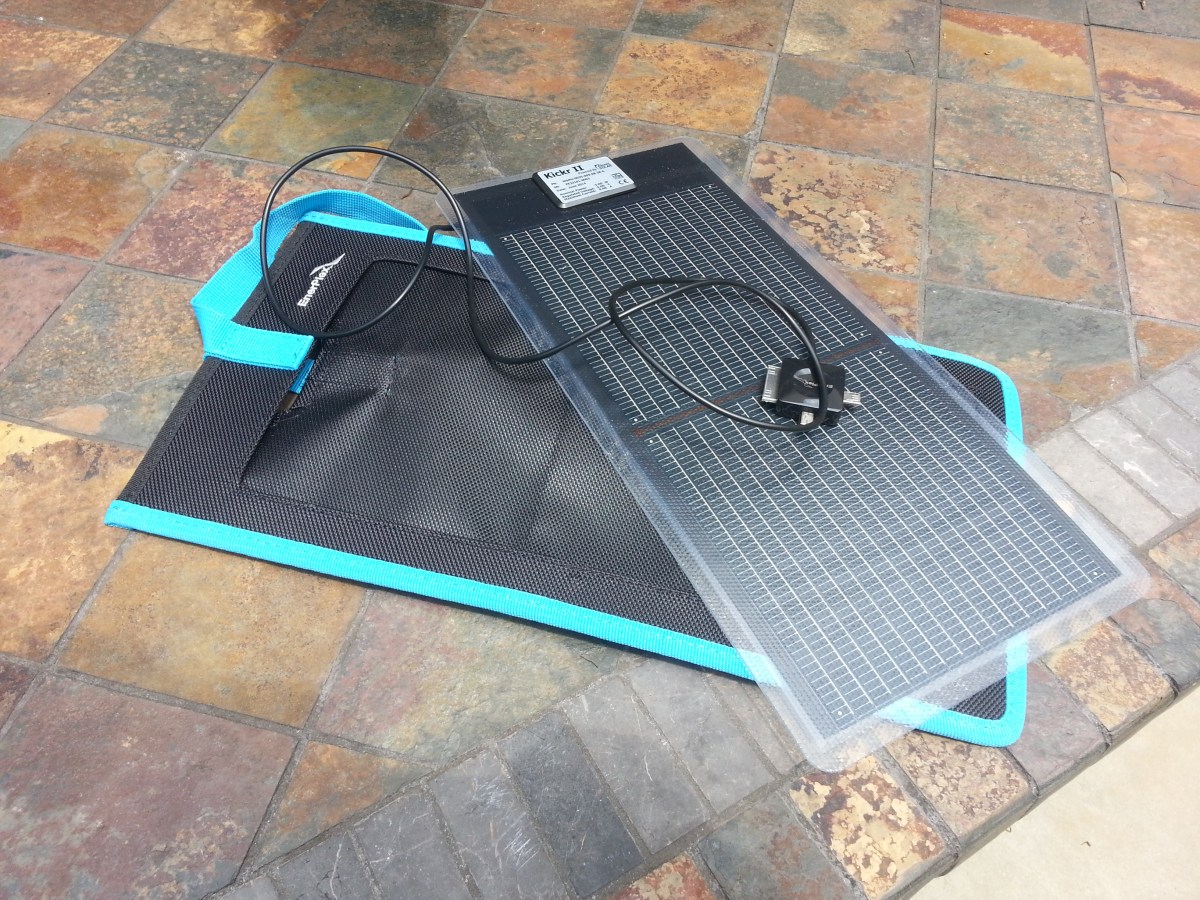EnerPlex sent us their Kickr II and Kickr IV solar panels to test. They specifically asked that we test their durability and even mentioned that the panels could be punctured and still work. So we did the only logical thing we could do in this situation: Shot one of them with guns and then ran it over with a Jeep. How did it hold up?
First, a review of the Kickr II and Kickr IV as solar panels instead of targets. I talked about the Kickr II a little bit when I reviewed the EnerPlex Packr, a backpack with the panel built in. It has a regulated output of 3.0 Watts, 5 Volts, and 0.6 Amps. All that output is fed through one USB port. It would feel more limiting to only have a USB port to power from if almost literally anything I wanted to charge didn’t use one. Tech hobbyists, makers, and DIY folks may yearn for more options, but for anyone just looking for a portable way to charge their phone, the USB port is probably enough.
The Kickr II can claims to be able to fully charge a Galaxy S4 in about four hours. It took about that long to charge my S3. It also says it can charge an iPhone 5 in three hours and an iPad Mini in nine.
The Kickr IV is a pretty decent step up. As the name might have you believe, it’s about twice as good. Not surprisingly it’s also nearly twice the price. EnerPlex also has the Kickr I, which is a single panel. I have not tested it, and only mention it to make the point that the Kickr I has a single panel, the II has two, and the IV has four. It’s an obvious naming convention but worth pointing out, because while one would assume that the Kickr IV is twice as large as the Kickr II, it’s not. It’s designed to fold up and as a result becomes a lot more portable and easier to carry around than the Kickr II, which has to stay flat.
Not the say the Kickr II is giant. It’s not. It’s just 14.25″ by 7.5″ and fits pretty easily into a backpack (especially the Packr, since it has one built in.) In contrast, the Kickr IV folds down to 8.8″ by 7.3″.
The Kickr IV’s additional panels mean you’re getting more power. Its regulated output is 6.0 Watts, 5 Volts, and 1.2 Amps. That means it charged my Galaxy S3 in about two hours, which is pretty comparable to just plugging it into the wall.
EnerPlex warned me that Apple users may experience problems trying to charge directly from the panel, since Apple products don’t like the fluctuations in current that happen with solar power. They recommend using one of their portable Jumpr battery packs in line with the panel so the phone isn’t charging off the panel directly. I typically found myself doing this anyway because it was more convenient to leave the panel and battery out in the sun than to be away from my phone, or worse, stay outside in the sun for two hours.
Along with the panels they also sent me their Jumpr Slate 10K, which is about the size of an iPad Mini and holds a 10,000mAh battery. It claims to be able to charge a Galaxy S3 3-4 times on a single charge. I was getting two full charges and most of a third. Charging the Jumpr off the panel took a full day out in the sun on the Kickr IV, which is understandable given the size of the battery, but even so it’s not the most convenient feature. Still though, if your goal in using solar panels is to reduce dependency on other forms of electricity, it’s possible to keep the Jumpr and your phone charged off the sun, at least as long as there are clear skies.
The Kickr panels are portable enough that they can be tossed in a bag as a backup plan of charging your gear on the go. They’d be great to bring to a convention or outdoor event. Also, as we found out, they’d hold up in a warzone. Here’s our “gun test,” where my assistants Keith Tickle and Richie Zaro fired a handgun and a shotgun at the Kickr II for me.
Yeah. Pretty durable. If it’s not clear in the video, we shot it twice with the handgun. As I was disappointed in the size of the bullet holes we stepped up to a shotgun, which blew a much more impressive hole. I was unable to do a direct comparison to see how much damage the output of the panel suffered, but I have used it since to charge my phone and didn’t notice it taking that much longer.
The Kickr II is listed on the EnerPlex site for $69.99, and the Kickr IV goes for $129.99. If you’re looking to pick one I’d recommend springing for the Kickr IV. Besides faster charging and more power, it’s just easier to carry with you. They’re probably not for everyone, but if you’re especially outdoorsy, go to a lot of festivals, or are prepping for the inevitable apocalypse and need something that can give you power and take a bullet, than the Kickr panels should seem pretty appealing.
(via EnerPlex, images my own)
- We beat the hell out of the Sonim Bolt “indestructible” phone
- Here what I thought of the Enerplex Packr solar backpack
- I still miss the Galaxy Note 3 I got to review
Are you following The Mary Sue on Twitter, Facebook, Tumblr, Instagram, & Google +?









Published: Aug 22, 2014 05:19 pm